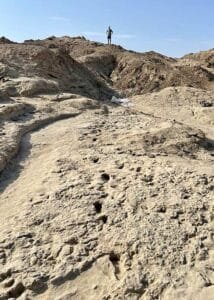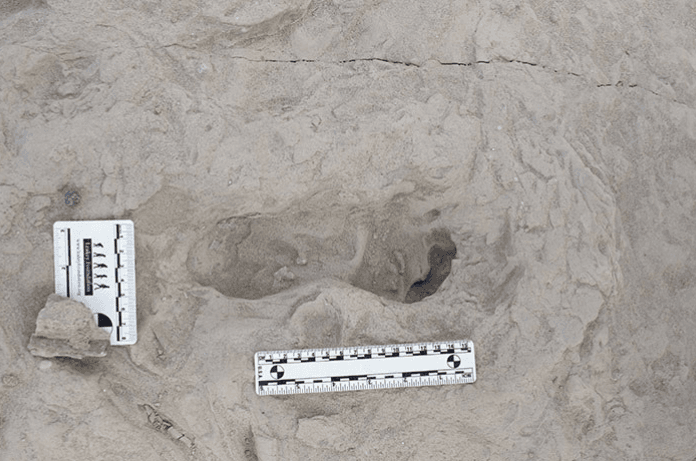More than a million years ago, on a sun-scorched savannah near the shores of what we now know as Lake Turkana in Kenya, two distinct species of hominins may have shared a fleeting moment in time. This groundbreaking discovery of fossil footprints, published in Science, marks the first-ever evidence of two different hominin species living simultaneously in the same habitat. The tracks were left by Homo erectus and Paranthropus boisei, two of the most prominent species of the Pleistocene Epoch.
These ancient human ancestors walked the same path, leaving behind not just footprints in the soft lakebed but a remarkable window into our evolutionary past. Their steps whether they crossed each other’s paths or simply followed hours apart offer unprecedented insights into the complex story of the human species.
A Rare Glimpse into the Distant Past
The 1.5-million-year-old footprints, unearthed in 2021 by a team led by Louise Leakey, represent an extraordinary find in biological anthropology. These fossilized “trace fossils” are unique because, unlike skeletal remains, they provide a snapshot of behavior frozen in time.
Hominin is a subgroup of a larger category known as hominids. Hominins include all species living and extinct within the human lineage after diverging from the ancestors of great apes about 6-7 million years ago. Trace fossils, such as these footprints, differ from body fossils like bones and teeth, as they remain in place, preserving evidence of activity rather than physical structure.
“This proves beyond any question that not only one, but two different hominins were walking on the same surface, literally within hours of each other,” said Craig Feibel, Professor in the Department of Earth at Rutgers University. Feibel, an expert in stratigraphy and dating, helped establish the geological context of the discovery, confirming that the prints were made on the same lakebed sediments 1.5 million years ago.
Homo erectus and Paranthropus boisei: Neighbors on the Savannah
While Homo erectus is recognized as a direct ancestor of modern humans, Paranthropus boisei is a now-extinct species known for its robust skull and strong jaws adapted to chewing tough vegetation. Both species shared bipedalism and upright postures, enabling them to traverse the harsh landscapes of ancient Africa with agility.

According to fossil records, Homo erectus persisted for over a million years, while Paranthropus boisei disappeared after a few hundred thousand years. Why one species thrived and the other perished remains a mystery, but their coexistence raises fascinating questions about competition, resource sharing, and potential interactions cultural or reproductive.
“Their presence on the same surface, made closely together in time, places the two species at the lake margin, using the same habitat,” Feibel explained.
Unlocking Ancient Behavior with Fossil Footprints
Unlike bones or tools, footprints provide direct evidence of behavior. “Fossil footprints are exciting because they provide vivid snapshots that bring our fossil relatives to life,” said Kevin Hatala, lead author of the study (he has been investigating hominin footprints since 2012) and associate professor at Chatham University. “With these kinds of data, we can see how individuals, millions of years ago, moved through their environments, potentially interacting with each other or other animals,” Hatala added.
Hatala’s team employed advanced 3D imaging techniques to analyze the footprints. Their findings revealed distinct differences in foot anatomy and walking styles between the two species. These patterns offer clues about their locomotion, environment, and even how they may have interacted.
The Serendipity of Discovery
The footprints were discovered by chance during excavations led by Cyprian Nyete’s local team in northern Kenya, a region renowned for its rich fossil record. Heavy rains had exposed the surface where the prints were embedded. Initially, the team noticed giant bird tracks, but soon they uncovered the first hominin footprint. Further excavation in 2022 revealed a full trackway, with parallel paths of Homo erectus and Paranthropus boisei.
Feibel described the discovery as “a bit of serendipity.” The meticulous work of the team ensured that this fleeting moment, preserved in sediment for over a million years, would shed light on a pivotal chapter of human history.
What the Footprints Tell Us About Our Evolutionary Journey
The overlapping tracks suggest that these two species coexisted in the same environment, scavenging for food and avoiding predators in a shared habitat. While skeletal fossils have long been the cornerstone of evolutionary research, footprints like these add a dynamic layer, offering glimpses of interaction and movement.
This discovery also supports the theory that two different hominins lived side by side, walking on the same surface, literally within hours of each other. However, much remains unknown about the extent of their interactions. Did they share resources? Did they influence each other’s cultural or survival strategies?
Footprints of the Past, Lessons for the Future
The fossilized footprints near Lake Turkana are more than just impressions in ancient mud they are a testament to the complexity of human evolution. They remind us of the challenges our ancestors faced and the adaptability that defines our lineage.
As Feibel aptly put it, “The idea that they lived contemporaneously may not be a surprise. But this is the first time demonstrating it. I think that’s really huge.”
By continuing to explore such discoveries, scientists hope to uncover more about how cooperation, competition, and environmental adaptation shaped the trajectory of human evolution.

